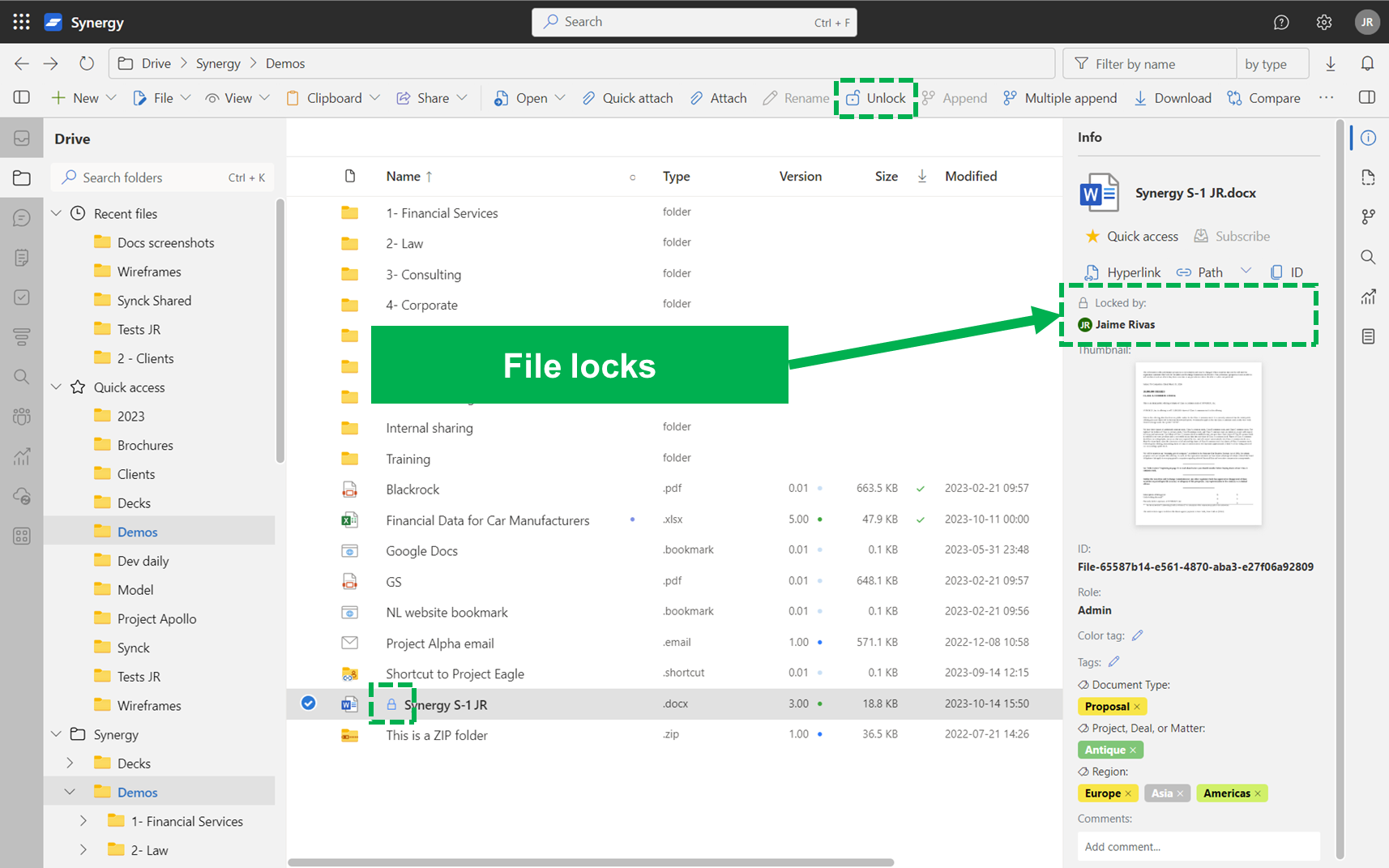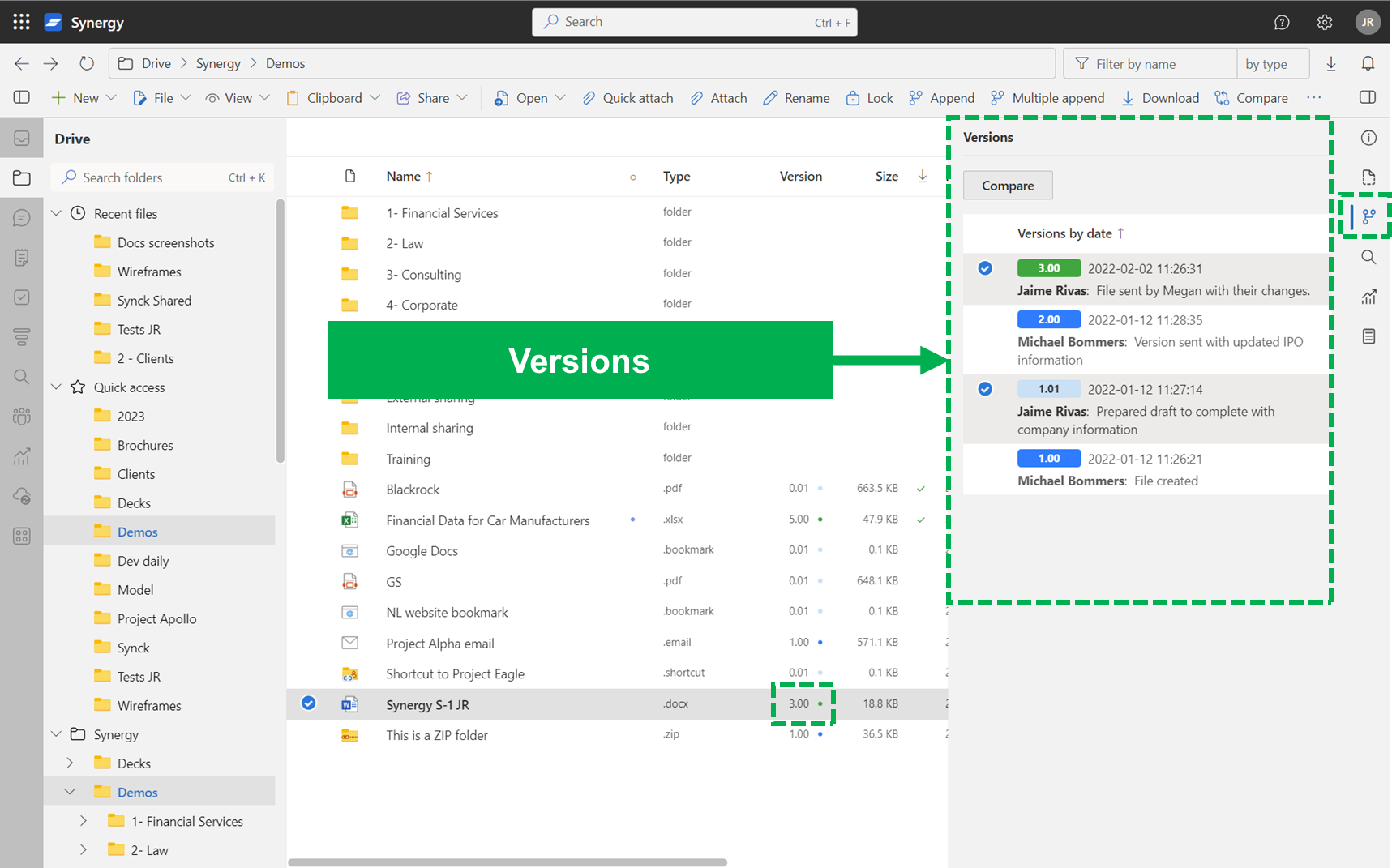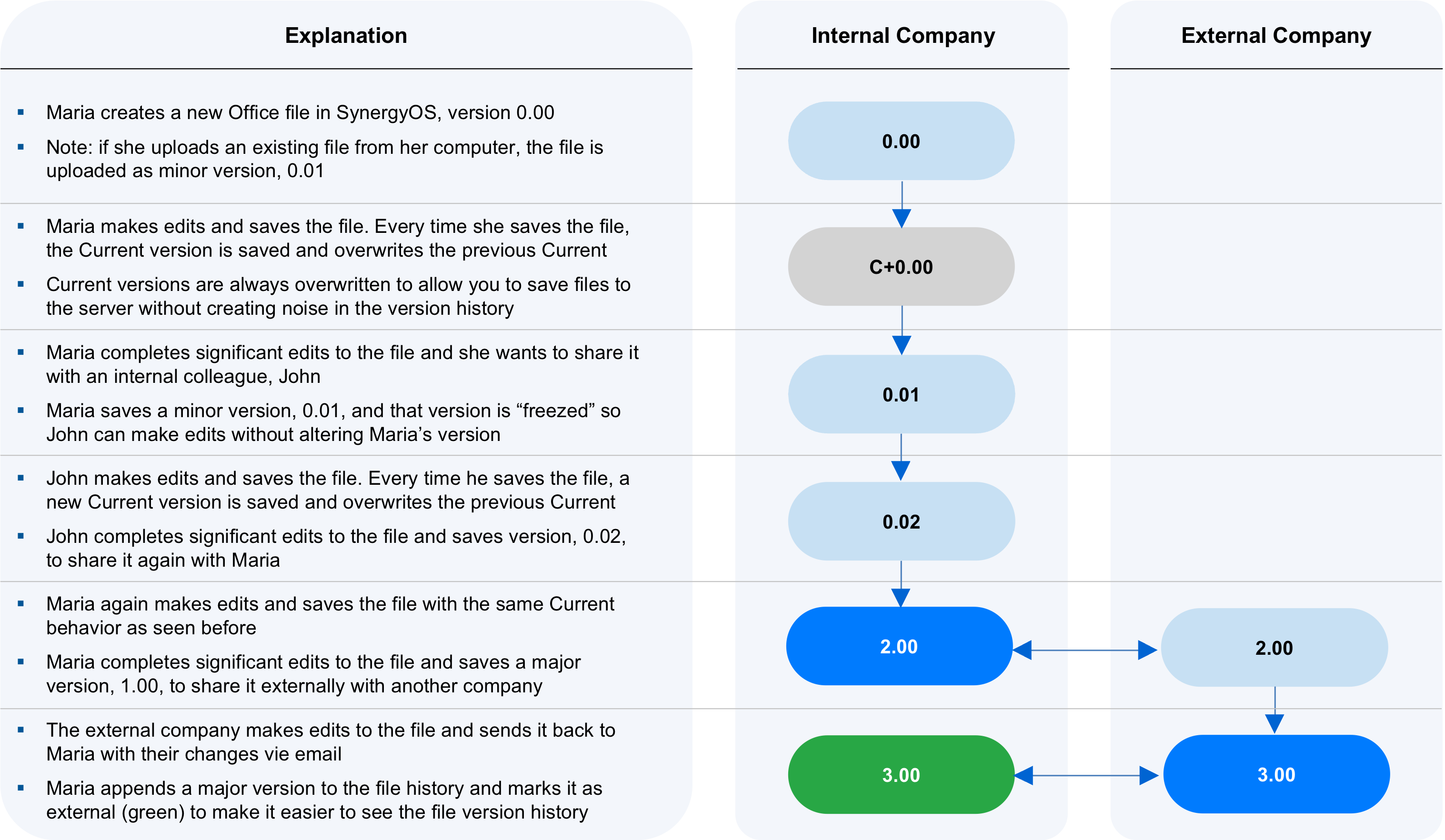Version Control, Co-Authoring, Activity
1. What It Is
SynergyOS combines version control, file locking, co-authoring, and full activity tracking into one unified system.
It helps teams collaborate in real time, avoid conflicts, and maintain a clear record of everything that happens — from edits and uploads to views and comments.
Version control applies to all files stored in Drive, and integrates with both desktop and online tools like Office, Photoshop, and more. You can lock files, track changes with minor or major versions, and enable real-time editing with shared locks.
Beyond content changes, SynergyOS also logs every action in the workspace — giving you full visibility into what was done, when, and by whom. All actions are recorded as commits or activities, making it easy to review progress, audit work, and maintain accountability across the system.
2. Why It Matters
When multiple users work on the same document — especially across teams and companies — traditional systems break down:
- Changes get lost or overwritten
- People use different copies with no traceability
- You lose track of what’s internal, what’s external, and what’s final
SynergyOS fixes that:
- ✅ No overwrites – Track minor edits, major versions, and optional overwrite
- ✅ Lock when needed – Avoid collisions with exclusive or shared file locks
- ✅ Contextual workflows – Use minor versions for internal, major for external
- ✅ Audit everything – View history, authors, and restore any previous version
- ✅ Works everywhere – Works with Office, Photoshop, and more
And at the workspace level:
- ✅ Tracks every change – Edits, uploads, deletes, moves, versioning — all captured as commits
- ✅ Records all access – Views, comments, searches, and other actions are logged too
- ✅ Improves transparency – See who’s active, who made changes, and what was impacted
- ✅ Supports compliance – Full history is retained and exportable
- ✅ Works across all content – Files, notes, tasks, emails, and more
3. How to Use It
Versioning in SynergyOS combines two key concepts:
🔒 File Locking
To avoid conflicts and preserve file integrity, SynergyOS supports three types of file locks.
Locking is especially important in shared environments where multiple users may edit the same file — or when you're going offline.
1. Exclusive Locks (Default for Office Files)
- Applied automatically when a file is opened in Microsoft Office
- File unlocks automatically when closed
- Prevents others from editing while you work
- Designed to avoid version conflicts in high-collaboration environments

2. On-Demand Locks (Manual)
Use this when:
- Editing non-Office files (e.g. Photoshop, Illustrator, PDFs)
- Working in Offline Mode (e.g. flights or low-connectivity environments)
How to use:
- Right-click the file → Lock File
- Optionally leave a comment explaining why you’re locking it (e.g. “Working offline, back in 3h”)
You can:
- Unlock your own locked files
- Force unlock files locked by others (they’ll receive an email notification and it’s logged in the audit trail)
3. Shared Locks (Co-authoring)
Used for real-time collaborative editing, typically in Office documents.
- Automatically applied in:
- Office Online
- SharePoint (desktop co-authoring)
- Allows multiple users to edit the same file simultaneously
- All changes are saved in real time
ℹ️ Shared locking for notes and text files is planned in future updates.
🧬 Version Control
SynergyOS has advanced file version control to provide seamless collaboration with anyone while maintaining file integrity. Each file in SynergyOS can have several types of versions:
| Type | Use Case | Example Label |
|---|---|---|
| Current | Work in progress, each save overwrites | C+1.00 |
| Minor Version | Internal updates, in-progress sharing | 1.01 |
| Major Version | Final versions for external sharing | 2.00 |
| Overwrite | Small corrections without creating a new version | — (no version bump) |

Each file can move between different version states as it evolves.
Current
- This is the default version.
- Every time you save the file, it overwrites the current version.
- There is always only one current version — for example,
C+1.00if editing from version1.00. - After each save, you’ll see a pop-up allowing you to promote it to a minor or major version.
Minor Version
- Saved manually from a current version when the changes are ready for internal review.
- Denoted by decimal increments, e.g.
1.01,1.02… up to1.99. - Used for collaborative work within your team — think drafts, progress updates, or comments.
- You can always return to a previous minor version.
Major Version
- Represents a significant milestone — typically when a file is complete and ready to be shared with clients or external collaborators.
- Denoted by the whole number before the dot, e.g.
2.00. - Every major version resets the minor count (e.g. after
2.00, the next minor could be2.01).
Overwrite Version
- Instead of saving a new version, you can overwrite the last one.
- Useful for fixing typos or making last-minute tweaks right after saving.
- This helps you avoid clutter in your version history with trivial changes.
Visual Example
Here’s how versions evolve in practice:

👥 Co-authoring
SynergyOS supports real-time co-authoring to help teams edit the same document simultaneously — without creating version conflicts or duplicated files.
All changes are saved to Current in real time and can later be promoted to minor or major versions.
Co-authoring relies on shared file locks, which are automatically applied when supported.
This feature is especially useful for time-sensitive work, client deliverables, or internal reviews involving multiple collaborators — including guests.
🟦 Co-authoring with Office Online
When a file is opened in Office Online, co-authoring is enabled automatically:
- Multiple users (internal or guests) can edit the same Word, Excel, or PowerPoint document
- Each user’s cursor and name are visible in real time
- Changes are saved to the Current version in SynergyOS
- No need to manually lock or unlock files
- Requires a valid Microsoft 365 license
How to use it:
- Select a file in Drive
- Click Open with Office Online
- Begin editing — others can join instantly
🖥️ Co-authoring with SharePoint (Office Desktop)
If your org uses the Microsoft SharePoint integration, co-authoring also works with the desktop Office apps (Word, Excel, PowerPoint):
- A SharePoint Co-Authoring session is created
- Shared file locks apply automatically
- All changes are synced back to SynergyOS once the session is finalized manually
- Best suited for users who prefer working natively in Office on their computer
- Requires a valid Microsoft 365 license
How to use it:
- Select a file
- Right-click → Open in SharePoint
- Edit with the desktop Office app
🧪 Co-authoring for Notes and Tasks (Beta)
We're extending real-time collaboration beyond Office — starting with Notes and Tasks.
In the current beta:
- Multiple users can edit the same note or task simultaneously
- Changes are visible live
- Shared file locking is enabled under the hood
This brings collaborative editing to internal docs, meeting notes, and shared checklists — without needing external tools.
📊 Activity Tracking
SynergyOS tracks everything users do — not just edits, but views, comments, and searches — through a unified activity system.
There are two main types of activity:
- Commits – Changes to content or structure (e.g. edits, uploads, deletions)
- Other Activities – Non-destructive actions (e.g. views, searches, comments)
This system gives you complete visibility over your workspace:
You can see who changed what, who viewed a file, or what was deleted — and when.
Use the Activity tab to filter by folder, user, date, or type of action.
Every event is logged with a timestamp, author, and relevant context.
✅ Ideal for project reviews, compliance audits, and tracking user engagement
✅ Includes export options and notification subscriptions
4. FAQ
Q: Can I see the activity of other users?
A: Only if you have permission to access the folder or file, you can view all commits and activities related to it.
Q: How long is activity history kept?
A: Indefinitely, unless limited by your organization’s retention policy.
Q: Can I export the activity log?
A: Yes. Use the Export button on the Activity page to download logs (e.g. CSV) for reporting or audits.
Q: Are there notifications for activity?
A: Yes. You can subscribe to folders and receive notifications on new commits or updates. Configure this in your notification settings.
Q: Can I force unlock someone else’s file?
A: Yes, if you have permission. The user will be notified, and the unlock action is recorded in the audit log.
Q: Can I prevent others from promoting a version?
A: Only users with write or edit access can create versions. Permissions are inherited from the folder.